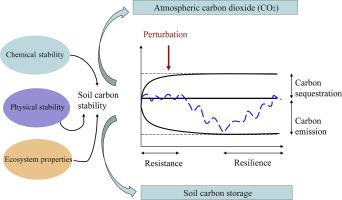当前位置:
X-MOL 学术
›
Earth Sci. Rev.
›
论文详情
Our official English website, www.x-mol.net, welcomes your feedback! (Note: you will need to create a separate account there.)
Soil organic carbon stability under natural and anthropogenic-induced perturbations
Earth-Science Reviews ( IF 12.1 ) Pub Date : 2020-06-01 , DOI: 10.1016/j.earscirev.2020.103199 Juejie Yang , Aiyang Li , Yunfeng Yang , Guanghe Li , Fang Zhang
Earth-Science Reviews ( IF 12.1 ) Pub Date : 2020-06-01 , DOI: 10.1016/j.earscirev.2020.103199 Juejie Yang , Aiyang Li , Yunfeng Yang , Guanghe Li , Fang Zhang

|
Abstract Soil organic carbon (SOC) plays key roles in determining soil properties, plant nutrients, and land-atmosphere carbon exchange, yet is affected by various natural and anthropogenic perturbations such as wildfire, climate change, land use change and pollution. Herein, we review perturbation types and SOC response mechanisms, as well as new technologies to measure SOC stability, highlighting the resistance and resilience of SOC. Although there is great controversy on the nature and structure of SOC, it has been recognized that the SOC stability not only depends on physiochemical characteristics of SOC, but also on soil microenvironment, soil microbial community composition, and types of perturbations. Based on ecosystem stability theories, the change of SOC stability under perturbation can be keeping stable states, changing to an alternative stable states or system collapse. For future studies, we suggest that understanding responses of soil biogeochemical processes to multiple perturbations, well-designed experiments to quantify threshold and uncertainty of SOC, and integration of novel biological approaches besides physicochemical characterizations into SOC stability are needed. This review helps to better understand the process of SOC stabilization and reduce the uncertainties in assessments of global carbon stocks, not only for mitigating the effects of climate change through negative feedbacks but also for maintaining soil functions such as soil fertility, water quality, and resistance to erosion.
中文翻译:

自然和人为扰动下的土壤有机碳稳定性
摘要 土壤有机碳(SOC)在决定土壤性质、植物养分和陆地-大气碳交换方面起着关键作用,但也受到野火、气候变化、土地利用变化和污染等各种自然和人为扰动的影响。在此,我们回顾了扰动类型和 SOC 响应机制,以及衡量 SOC 稳定性的新技术,突出了 SOC 的抵抗力和弹性。尽管对 SOC 的性质和结构存在很大争议,但人们已经认识到 SOC 的稳定性不仅取决于 SOC 的理化特性,还取决于土壤微环境、土壤微生物群落组成和扰动类型。基于生态系统稳定性理论,扰动下SOC稳定性的变化可以保持稳定状态,改变到另一种稳定状态或系统崩溃。对于未来的研究,我们建议了解土壤生物地球化学过程对多重扰动的响应、精心设计的实验来量化 SOC 的阈值和不确定性,以及将除物理化学表征之外的新生物方法整合到 SOC 稳定性中。这篇综述有助于更好地理解 SOC 稳定的过程,减少全球碳储量评估的不确定性,不仅可以通过负反馈减轻气候变化的影响,还可以维护土壤功能,如土壤肥力、水质和抵抗力。侵蚀。需要精心设计的实验来量化 SOC 的阈值和不确定性,并且需要将除物理化学表征之外的新生物方法整合到 SOC 稳定性中。这篇综述有助于更好地理解 SOC 稳定的过程,减少全球碳储量评估的不确定性,不仅可以通过负反馈减轻气候变化的影响,还可以维护土壤功能,如土壤肥力、水质和抵抗力。侵蚀。需要精心设计的实验来量化 SOC 的阈值和不确定性,并且需要将除物理化学表征之外的新生物方法整合到 SOC 稳定性中。这篇综述有助于更好地理解 SOC 稳定的过程,减少全球碳储量评估的不确定性,不仅可以通过负反馈减轻气候变化的影响,还可以维护土壤功能,如土壤肥力、水质和抵抗力。侵蚀。
更新日期:2020-06-01
中文翻译:

自然和人为扰动下的土壤有机碳稳定性
摘要 土壤有机碳(SOC)在决定土壤性质、植物养分和陆地-大气碳交换方面起着关键作用,但也受到野火、气候变化、土地利用变化和污染等各种自然和人为扰动的影响。在此,我们回顾了扰动类型和 SOC 响应机制,以及衡量 SOC 稳定性的新技术,突出了 SOC 的抵抗力和弹性。尽管对 SOC 的性质和结构存在很大争议,但人们已经认识到 SOC 的稳定性不仅取决于 SOC 的理化特性,还取决于土壤微环境、土壤微生物群落组成和扰动类型。基于生态系统稳定性理论,扰动下SOC稳定性的变化可以保持稳定状态,改变到另一种稳定状态或系统崩溃。对于未来的研究,我们建议了解土壤生物地球化学过程对多重扰动的响应、精心设计的实验来量化 SOC 的阈值和不确定性,以及将除物理化学表征之外的新生物方法整合到 SOC 稳定性中。这篇综述有助于更好地理解 SOC 稳定的过程,减少全球碳储量评估的不确定性,不仅可以通过负反馈减轻气候变化的影响,还可以维护土壤功能,如土壤肥力、水质和抵抗力。侵蚀。需要精心设计的实验来量化 SOC 的阈值和不确定性,并且需要将除物理化学表征之外的新生物方法整合到 SOC 稳定性中。这篇综述有助于更好地理解 SOC 稳定的过程,减少全球碳储量评估的不确定性,不仅可以通过负反馈减轻气候变化的影响,还可以维护土壤功能,如土壤肥力、水质和抵抗力。侵蚀。需要精心设计的实验来量化 SOC 的阈值和不确定性,并且需要将除物理化学表征之外的新生物方法整合到 SOC 稳定性中。这篇综述有助于更好地理解 SOC 稳定的过程,减少全球碳储量评估的不确定性,不仅可以通过负反馈减轻气候变化的影响,还可以维护土壤功能,如土壤肥力、水质和抵抗力。侵蚀。



























 京公网安备 11010802027423号
京公网安备 11010802027423号